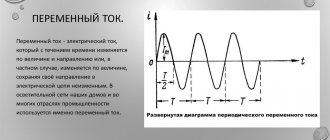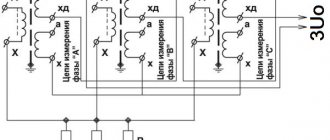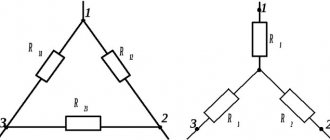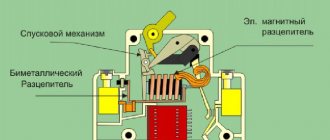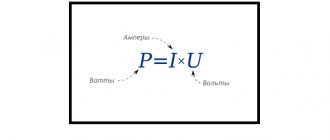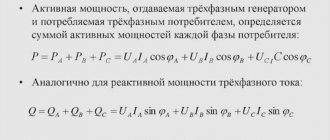On household appliances (mixer, hair dryer, blender), manufacturers write the power consumption in watts, on devices that require large amounts of electrical load (electric stove, vacuum cleaner, water heater) - in kilowatts. And on sockets or circuit breakers through which devices are connected to the network, it is customary to indicate the current strength in amperes. To understand whether the outlet will support the device you are connecting, you need to know how to convert amps to watts.
What is power Watt [W]
Power is a quantity that determines the ratio of work performed by a current source over a certain period of time. One watt corresponds to the product of one ampere and one volt, but when determining energy costs, the value of kilowatt/hour .
It corresponds to the consumption of one thousand watts for 60 minutes of operation. It is by this indicator that the cost of electricity services is determined.
In most cases, the power consumed by the device is indicated in the technical documentation or on the packaging. The specified quantity is produced in one hour of work.
For example, a computer with a 500 W power supply will spin 1 kW for 2 hours of operation.
To help determine the current strength at a known power, a calculator will help, which converts one physical quantity to another.
What characteristics determine the current strength of 1 ampere?
The formal definition of this unit - ampere - was introduced in 1948 at the proposal of the CIPM (International Committee of Weights and Measures). It states that an ampere is the force of a direct current that flows through infinitely thin long parallel conductors, spaced 1 meter apart and located in a vacuum, causing an interaction between them of a force of 2 × 10−7 newtons for each section 1 meter long.
In practice, it is impossible to reproduce the determination conditions; conductors have both a finite length and a specific cross-section. Typically, the interaction force is determined between two coils with a large number of turns of wire. Until 1992, this principle was the basis for determining the ampere standard on current scales. In this case, the force or moment of forces acting on a coil with current placed in a magnetic field was measured. The strength of electric current is measured with an ammeter.
Since 1992, the ampere standard in the Russian Federation has been determined indirectly using Ohm’s law, due to which the error in the value has decreased by two orders of magnitude.
The strength of an electric current can be represented as the rate of change of charge, i.e. 1 ampere is the current strength when for every second an amount of electricity equal to 1 coulomb (6.241·10¹⁸ electrons) passes through the diameter of the conductor.
What is Current Strength. Ampere [A]
Current is the speed at which electrical charge flows through a conductor. One ampere is equal to a charge of one coulomb that passes through a conductor in one second. One coulomb represents a very large charge, so in most devices this value is measured in milliamps.
The current strength depends on the cross-section of the conductor and its length. This must be taken into account when planning structures, as well as choosing electrical appliances. Although most should not think about this, since this is the task of engineers and designers.
How many watts are in 1 ampere?
To determine the power of a circuit, the concept of voltage is also important. This is the electromotive force that moves electrons. It is measured in volts. Most devices have this characteristic in their documentation.
To determine the power at a current of one ampere, you need to know the network voltage. So, for a 220 volt outlet it will be: P = 1 * 220 = 220 W. Formula for calculation: P = I*U, where I is current and U is voltage. In a three-phase network, a correction factor must be taken into account, reflecting the percentage of operating efficiency. In most cases it is between 0.67 and 0.95.
Converting amperes to watts and kilowatts
Knowing how to calculate the correspondence between amperes and watts is necessary in order to determine which device can withstand the power of connected consumers. Such devices include protective equipment or switching equipment.
Before choosing which circuit breaker or residual current device (RCD) to install, you need to calculate the power consumption of all connected devices (iron, lamps, washing machine, computer, etc.). Or, on the contrary, knowing the cost of a circuit breaker or protective shutdown device, determine which equipment will withstand the load and which will not.
To convert amperes to kilowatts and vice versa, there is a formula: I=P/U, where I are amperes, P are watts, U are volts. Volts are the mains voltage. In residential premises, a single-phase network is used - 220 V. In production, to connect industrial equipment, a three-phase electrical network is used, the value of which is 380 V. Based on this formula, knowing the amperes, you can calculate the correspondence to watts and vice versa - convert watts to amperes.
Ampere – Watt conversion table
To convert watts to amperes, you need to use the previous formula, expanding it. To calculate the current, you need to divide the power by the voltage: I = P/U. The following table shows the amperage for devices with different voltages - 6, 12, 24, 220 and 380 volts.
Remember that for high voltage networks, the specified amperage differs depending on the efficiency.
Table of the ratio of amperes and watts, depending on voltage.
| 6V | 12V | 24V | 220V | 380V | |
| 5 W | 0.83A | 0.42A | 0.21A | 0.02A | 0.008A |
| 6 W | 1.00A | 0.5A | 0.25A | 0.03A | 0.009A |
| 7 W | 1.17A | 0.58A | 0.29A | 0.03A | 0.01A |
| 8 W | 1.33A | 0.66A | 0.33A | 0.04A | 0.01A |
| 9 W | 1.5A | 0.75A | 0.38A | 0.04A | 0.01A |
| 10 W | 1.66A | 0.84A | 0.42A | 0.05A | 0.015A |
| 20 W | 3.34A | 1.68A | 0.83A | 0.09A | 0.03A |
| 30 W | 5.00A | 2.5A | 1.25A | 0.14A | 0.045A |
| 40 W | 6.67A | 3.33A | 1.67A | 0.13A | 0.06A |
| 50 W | 8.33A | 4.17A | 2.03A | 0.23A | 0.076A |
| 60 W | 10.00A | 5.00A | 2.50A | 0.27A | 0.09A |
| 70 W | 11.67A | 5.83A | 2.92A | 0.32A | 0.1A |
| 80 W | 13.33A | 6.67A | 3.33A | 0.36A | 0.12A |
| 90 W | 15.00A | 7.50A | 3.75A | 0.41A | 0.14A |
| 100 W | 16.67A | 3.33A | 4.17A | 0.45A | 0.15A |
| 200 W | 33.33A | 16.66A | 8.33A | 0.91A | 0.3A |
| 300 W | 50.00A | 25.00A | 12.50A | 1.36A | 0.46A |
| 400 W | 66.66A | 33.33A | 16.7A | 1.82A | 0.6A |
| 500 W | 83.34A | 41.67A | 20.83A | 2.27A | 0.76A |
| 600 W | 100.00A | 50.00A | 25.00A | 2.73A | 0.91A |
| 700 W | 116.67A | 58.34A | 29.17A | 3.18A | 1.06A |
| 800 W | 133.33A | 66.68A | 33.33A | 3.64A | 1.22A |
| 900 W | 150.00A | 75.00A | 37.50A | 4.09A | 1.37A |
| 1000 W | 166.67A | 83.33A | 41.67A | 4.55A | 1.52A |
Using the table it is also easy to determine the power if the voltage and current are known. This is useful not only for calculating energy consumption, but also for choosing special equipment responsible for uninterrupted operation or preventing overheating.
Ampere's Law - Definition
A. M. Ampere not only gave his name to the unit of current, but also established a law that determines the force of action of a uniform magnetic field on a conductor placed in it. Its value is directly proportional to the length of the conductor, the strength of the current flowing through it, the vector of magnetic induction and the sine of the angle between the vector and the direction of the current.
The physicist was the first to establish the peculiarities of the interaction of two conductors with current. The directional movement of electrons - the flow of current in them - causes the attraction of conductors (the current flows in the same direction for both) or the repulsion of these wires in the opposite direction of current flow.
The following characteristics of the processes give an idea of the current strength:
— in the lightning channel it is approximately 500 kiloamperes (1 kA = 10³ A);
— a current of ≈ 0.5 A flows in a switched-on 100-watt light bulb;
— the approximate current strength during treatment with electrophoresis is 0.8 mA (1 mA = 0.001A);
— a current of up to 10 A passes through the heating element of the electric heater.
In a closed circuit, at any place in the circuit, the same amount of electricity passes through the diameter of the conductor every second, i.e., the current strength in each section of the circuit is the same. Its value does not depend on the thickness of the electrical conductor, since charges do not tend to accumulate in one place.
Dangerous current values
Electrical damage varies and is influenced by three factors:
- What is the frequency: constant or variable;
- Force;
- In what direction does it move as it passes through the body?
The effect of electric current on a person
Electric current is also divided depending on how it affects human health:
- Noticeable - only irritates the skin. Safe value – no more than 0.6 milliamps;
- Non-releasing - variable with periodic impulses, due to which a person “sticks” to the source of electricity. Happens if the current exceeds 0.025 amperes;
- Fibrillation – it causes fibrillation of internal organs, primarily the heart. If the electrical strength exceeds 0.1 ampere, the organ may stop.
Need to know! The human body resists electricity. The force of the blow depends on many factors: the health of the victim at the time of the blow, mental state and even the quality of the shoes. Based on the electrical resistance values, current voltage readings that are dangerous to humans are derived.
Based on safety precautions, the following voltage indicators are dangerous:
- 65 volts – residential premises and public buildings that are heated and have internal humidity up to 60%;
- 36 volts – rooms with high humidity levels (up to 75%). These are basements, kitchens, and so on;
- 12 volts – very wet spaces (100%): swimming pool, bathhouse, laundry room, boiler room, and so on.
Note! The frequency of the electric current also plays a role. A value from 50 to 60 hertz is considered dangerous for humans.
Outcome of electric shock
Situations are different, so the outcome of an electric shock varies. When receiving a strong electric shock, problems with blood circulation and breathing are caused. Severe cases are characterized by cardiac fibrillation: the heart muscles twitch chaotically. In fact, the heart stops functioning normally, so in such a situation, prompt medical intervention is required.
Often, electric shock has a force of up to 1000 V. Burns occur if the force exceeds 1 A. The most common reason is a person’s failure to comply with safety regulations. The element through which electricity passes is located close to the human body, resulting in a spark discharge resulting in varying degrees of burns. When accidentally receiving a spark discharge, the current in contact with the body heats the tissue to 60 degrees Celsius. The protein begins to coagulate, and subsequently a burn appears on the affected area. Electrical burns are dangerous because they are quite difficult to cure.
Electric shock can have different consequences
Hazards of AC and DC Current
Human resistance
It is known that electric current can be constant or variable, but not every resident understands the difference between them and knows which has a more serious effect on the body. When asked which current is more dangerous, experts answer – alternating.
Passing through the body
This is explained by the fact that a direct electric current must be three times more powerful than an alternating current in order to be deadly to human health. Variable – faster and stronger, which has a greater effect on nerve endings and muscle tissue (primarily the heart). The electrical resistance of people is covered by direct current power (no more than 50 milliamps). In the case of alternating current, the limit drops to 10 milliamps. If the electrical voltage reaches 500 volts, then both types of current cause equal harm. If the indicator rises, constant electric current is more dangerous in such a situation.
The biological effect of electricity directly depends on the intensity with which the body is exposed to it, and this is an important factor due to which fibrillation of the ventricles of the heart occurs. Lethal electric current for humans is prolonged contact with electrical conductors with a force of 0.25-80 mA. This causes spasms of the respiratory muscles and, as a result, acute asphyxia.
Electricity spreads throughout the body only if there is a point of entry and exit for the current. That is, you need to touch two electrodes at the same time. We are talking about bipolar connection or contact with one electrode. If a part of the human body is grounded, then such a connection is called single-pole. There is also a partial switching on, in which a person isolated from the ground touches opposite poles. In this case, it will pass through the switched-on segment of the arm, and this, as a rule, is not a dangerous current. If there is a high voltage, then an electric shock can strike even if there is no direct contact with the conductor: that is, at a distance, through an arcing contact that occurs if you approach it. Air ionization is the reason that a person comes into contact with installations or wires through which electricity passes. The current of electricity is dangerous for humans, especially in damp weather, since the electrical conductivity of the air is increased. In the case of ultra-high voltage, the electric arc reaches a length of 35 cm.
Electric current is dangerous for the human body, so basic safety requirements must be observed. It itself can be constant and variable, each affecting a person in its own way. Safe work with electrical installations - compliance with all rules and use of protective equipment.


